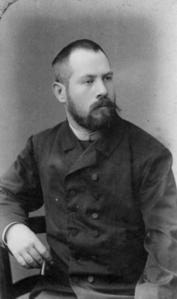Lovis Corinth
German
(Tapiau, East Prussia, 1858 - 1925, Amsterdam, The Netherlands)
Lovis Corinth was a German artist of the turn-of-the-20th-century, who has been long neglected internationally. His dramatic paintings and dark, moody graphics place him in a no-man's land between the 19th-century academic tradition and the early 20th-century Expressionists. The quality of his work has sustained a faithful following for him in Germany. In 1992 there was an exhibition of his works at the National Academy of Design in New York, which led to exhibitions at the National Gallery of Art, the Busch-Reisinger Museum at Harvard, the St. Louis Art Museum and the National Gallery in Berlin. The Galerie St. Etienne in New York regularly exhibits examples of his works.
Corinth's prints make up a large portion of his oeuvre; nine hundred and eighteen have been catalogued. His friend, Hermann Struck, encouraged his printmaking, which resulted in Corinth producing prints at an increasing pace from 1908, until he was making over one hundred a year by the early 1920s. He favored drypoint over etching, but he chose lithography as the technique for book illustrations.
His earlier prints depict historical subject matter executed in an impressionistic manner with a basis in academic training. He was regarded most for his prints and paintings from the first decade of the twentieth century.
"... Corinth was recognized as the foremost of the now fashionable German Impressionists, after Liebermann, and his large paintings of religious or mythological subjects became very fashionable."(1)
Stylistic changes came after the artist suffered a stroke that left him partially paralyzed and caused his hand to tremble for the rest of his life.(2) Dealing with this handicap led to an emotional struggle questioning how to persist as an artist. His subjects became grounded in the brutal honesty of emotions. He chose to create landscapes and portraits at this point in his career, resulting in a group of remarkable works, though his contemporaries referred to them as degenerate because of the changes in style due to the severity of his illness.(3)
(1)Frances Carey and Antony Griffiths, The Print in Germany, 1880-1933: The Age of Expressionism. (London: British Museum Press, 1984), p. 81.
(2)Horst Uhr, Masterpieces of German Expressionism at The Detroit Institute of Arts. (Detroit: The Detroit Institute of Arts, 1982), p. 55.
(3)______________, Lovis Corinth, 1858-1925. (Memphis: The Dixon Gallery and Gardens, 1979), p. 11.
L. Burgess 5/8/95
Image credit: Lovis Corinth in Paris, 1887, Photograph courtesy of Wikimedia Commons, CC-BY-03
German
(Tapiau, East Prussia, 1858 - 1925, Amsterdam, The Netherlands)
Lovis Corinth was a German artist of the turn-of-the-20th-century, who has been long neglected internationally. His dramatic paintings and dark, moody graphics place him in a no-man's land between the 19th-century academic tradition and the early 20th-century Expressionists. The quality of his work has sustained a faithful following for him in Germany. In 1992 there was an exhibition of his works at the National Academy of Design in New York, which led to exhibitions at the National Gallery of Art, the Busch-Reisinger Museum at Harvard, the St. Louis Art Museum and the National Gallery in Berlin. The Galerie St. Etienne in New York regularly exhibits examples of his works.
Corinth's prints make up a large portion of his oeuvre; nine hundred and eighteen have been catalogued. His friend, Hermann Struck, encouraged his printmaking, which resulted in Corinth producing prints at an increasing pace from 1908, until he was making over one hundred a year by the early 1920s. He favored drypoint over etching, but he chose lithography as the technique for book illustrations.
His earlier prints depict historical subject matter executed in an impressionistic manner with a basis in academic training. He was regarded most for his prints and paintings from the first decade of the twentieth century.
"... Corinth was recognized as the foremost of the now fashionable German Impressionists, after Liebermann, and his large paintings of religious or mythological subjects became very fashionable."(1)
Stylistic changes came after the artist suffered a stroke that left him partially paralyzed and caused his hand to tremble for the rest of his life.(2) Dealing with this handicap led to an emotional struggle questioning how to persist as an artist. His subjects became grounded in the brutal honesty of emotions. He chose to create landscapes and portraits at this point in his career, resulting in a group of remarkable works, though his contemporaries referred to them as degenerate because of the changes in style due to the severity of his illness.(3)
(1)Frances Carey and Antony Griffiths, The Print in Germany, 1880-1933: The Age of Expressionism. (London: British Museum Press, 1984), p. 81.
(2)Horst Uhr, Masterpieces of German Expressionism at The Detroit Institute of Arts. (Detroit: The Detroit Institute of Arts, 1982), p. 55.
(3)______________, Lovis Corinth, 1858-1925. (Memphis: The Dixon Gallery and Gardens, 1979), p. 11.
L. Burgess 5/8/95
Image credit: Lovis Corinth in Paris, 1887, Photograph courtesy of Wikimedia Commons, CC-BY-03
Artist Objects

